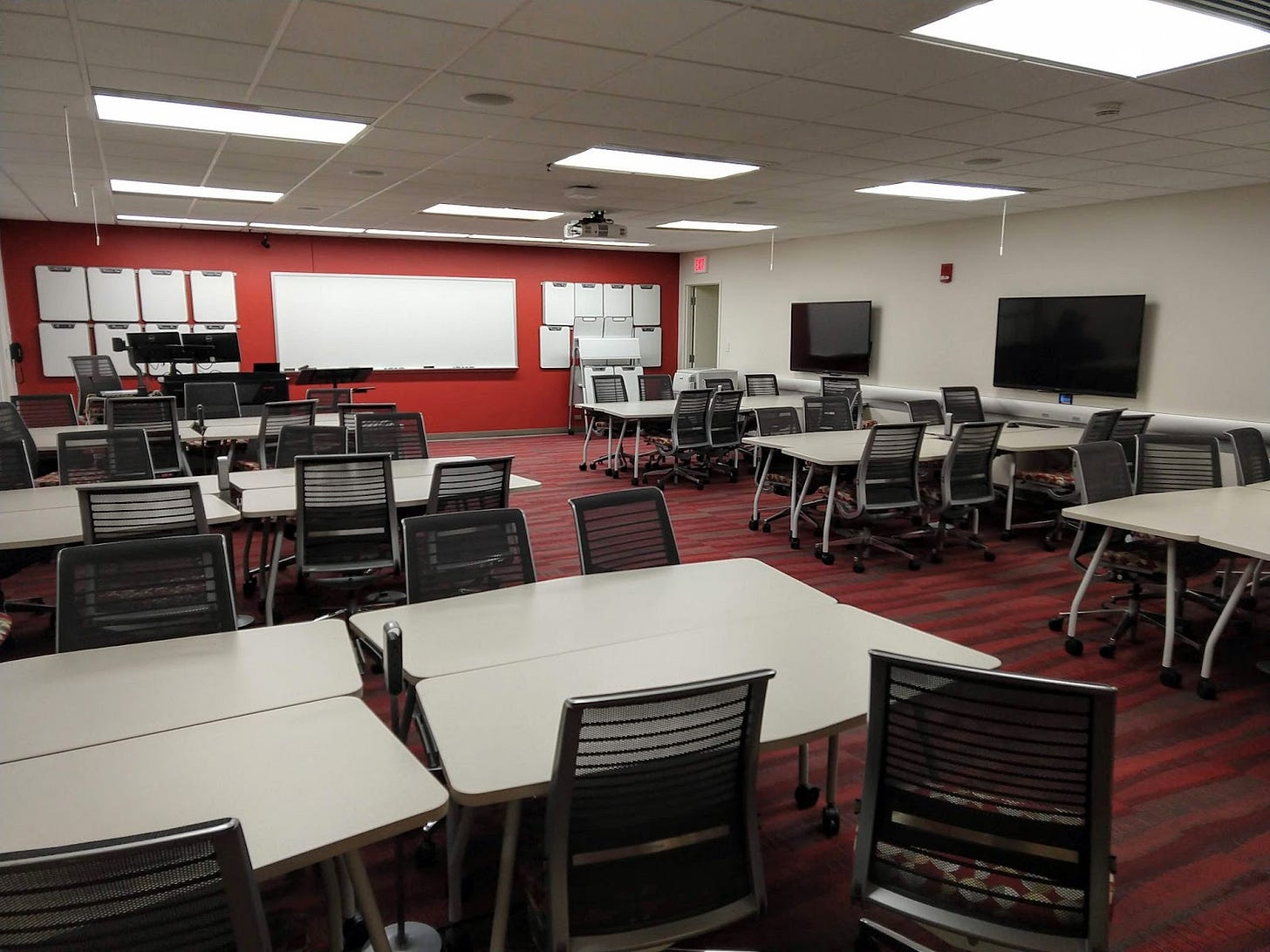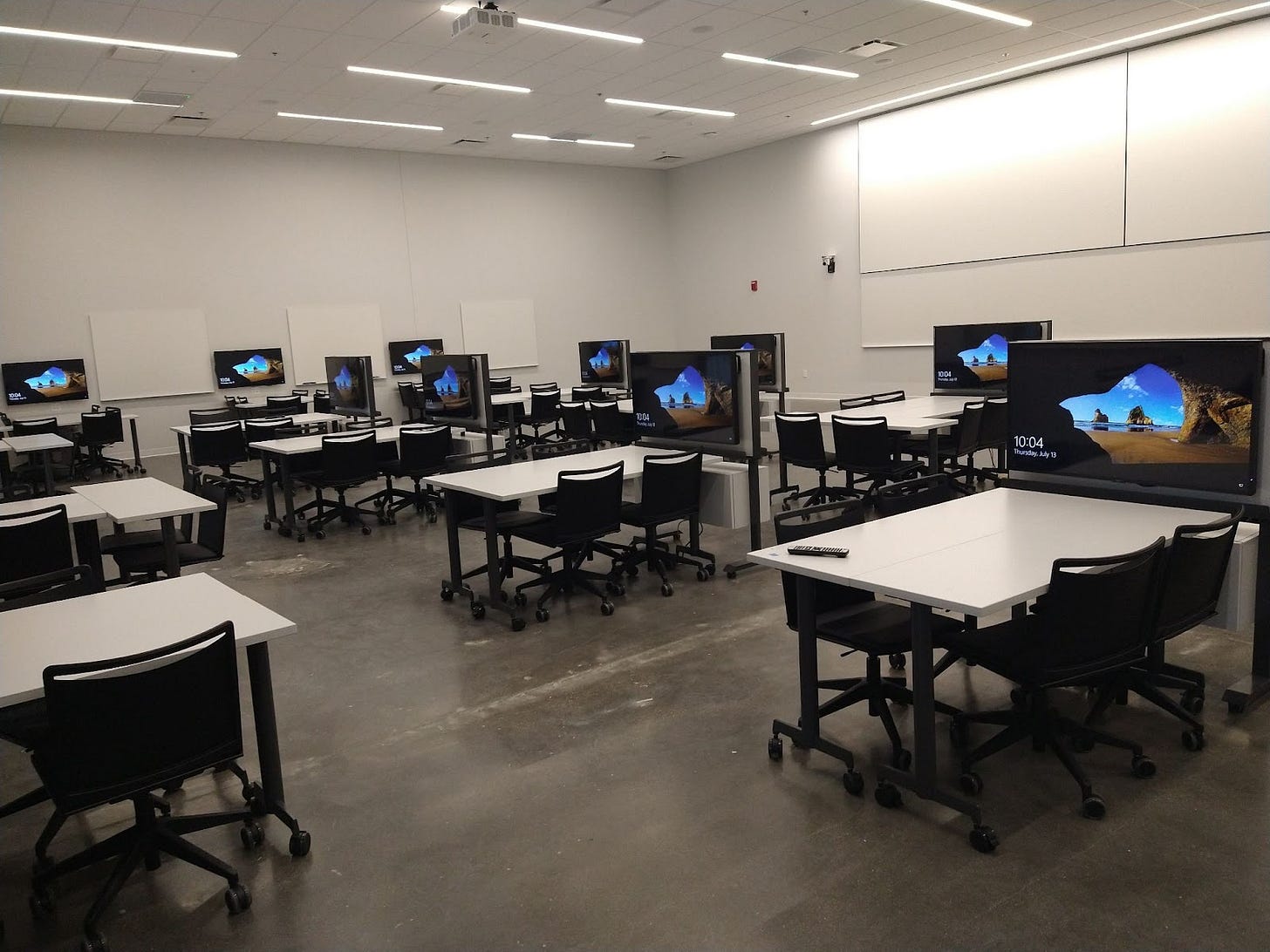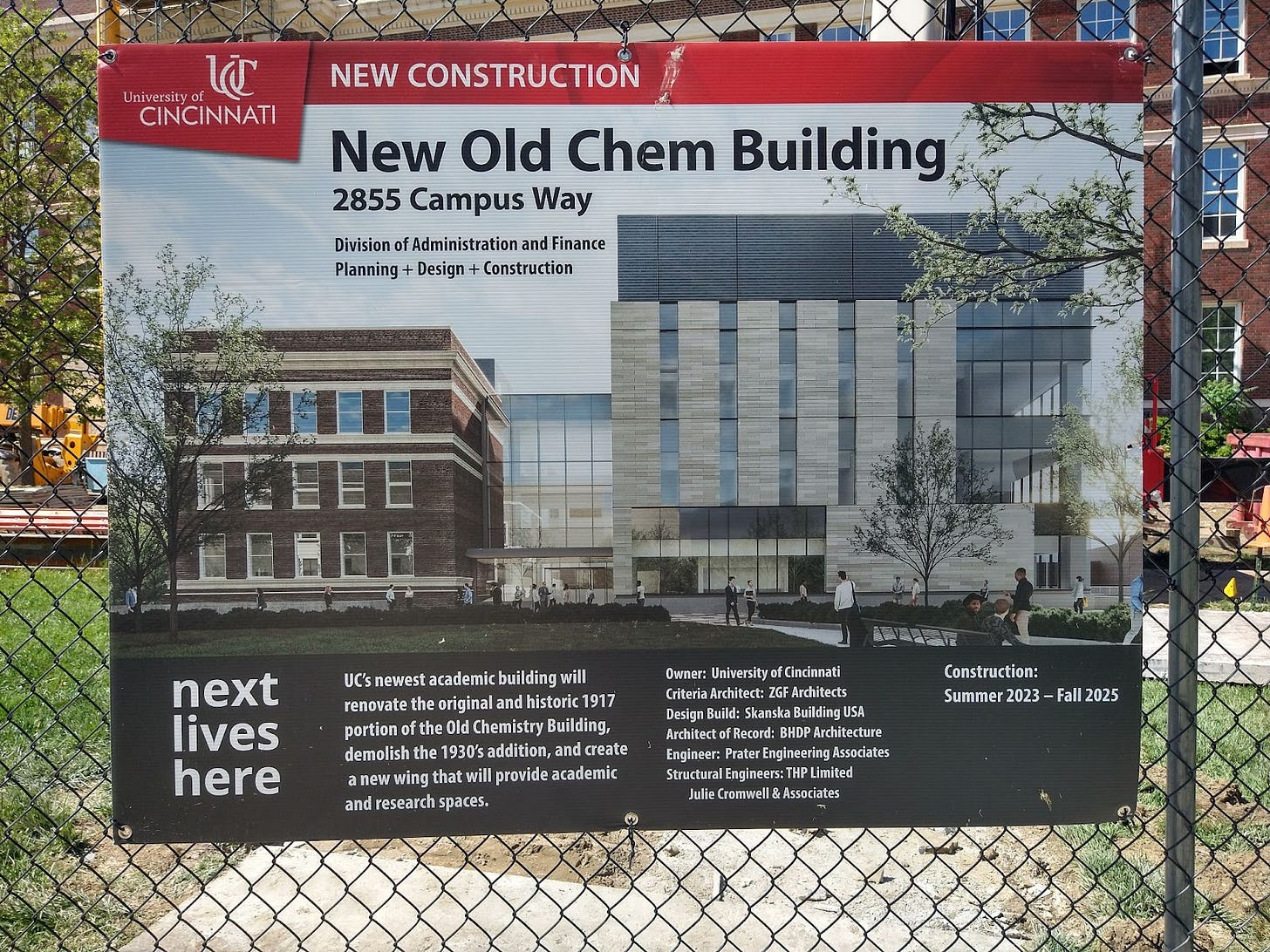When I began working in the field of educational development, contributing to the classroom design process was not on my bingo card. While the first TEAL classroom at University of Cincinnati opened in 2016, it wasn’t until 2019 when the institution began plans for a new building called Clifton Court Hall that was going to consist of almost entirely Active Learning Classrooms (ALCs) and Technology Enhanced Active Learning (TEAL) classrooms.
At the time, I was an Assistant Director in our Center for the Enhancement of Teaching & Learning. My role included supporting faculty teaching in our TEAL classroom through creating resources, facilitating cohort-based programs, and conducting consultations. I was invited to a Clifton Court Hall design meeting as a sort of “classroom consultant” along with several stakeholders from across the institution, such as IT, the registrar’s office, and leadership from the college that would use the building the most.
This was exciting and uncharted territory for me, both providing input on classroom design and being in meetings with such a wide array of staff. After a few design meetings, a handful of the staff, including myself, realized that our expertise and our units were intertwined in both designing classrooms and supporting faculty who would be teaching in these spaces. We decided to keep meeting as we each began working on how we would support the people using these new classrooms.
What began as a few staff contributing to a meeting became an organic collaboration, which felt refreshing and unusual in higher education, where we often work solely within our units and (perhaps) update one another. Working together strengthened each of our contributions to the Clifton Court Hall project.
Our initial group consisted of University of Cincinnati staff:
Matt Barrett, assistant registrar, Registrar’s office
Joe Willging, planner, Planning, Design + Construction office
Jason Litmer, assistant director, Electronic Classroom Support Services
Anna Donnell, assistant director of innovative pedagogy & course design, Center for the Enhancement of Teaching and Learning
As we considered potential enrollment and classroom sizes, classroom layouts, technology, and how faculty would transition to teaching in these new spaces, the four of us began to realize how we were engaging in integrated design. Good classroom design has to take into account not only the physical space (e.g. lighting, whiteboards, ceiling heights, furniture) but also pedagogy, technology, and the people who will use the space.
As we were learning from each other’s expertise during the planning process, we provided feedback to the external architecture firm and University of Cincinnati’s Planning, Design + Construction team, and discussed how each of our units would support faculty in these classrooms. We called ourselves the “Active Learning Classroom Coordination Team” to make our informal group (that wasn’t really a committee and didn’t really report to anyone) seem at least a little more official.
The vision of Clifton Court Hall was to use this new building as a stepping stone to more innovative teaching and active learning. Our Active Learning Classroom Coordination Team continued to meet on our own as the design and construction began because we all felt that while input on the design was great, we needed to consider the students who would be learning in the space, the instructors that would be teaching in the space, and how each of our units would support them.
By this point, Matt Barrett had moved to Space Management and Aaron Bauer had joined the Registrar’s office, so we became a group of five. We brainstormed what would support the people in these new classrooms, then we turned our ideas into new processes and resources.
We partnered with Stephanie Korslund, senior instructional designer in the College of Arts and Sciences, as we developed resources and a workshop for faculty teaching in the spaces and collected feedback. Some of the early work that came out of this group included:
Creating a designation for ALCs and TEAL classrooms in our space management software
Creating a process for faculty to request to teach in one of these spaces and communicating this new process to the colleges
Updating our tutorial article on technology in a centrally scheduled classroom to include more information on the technology in TEAL classrooms
Developing teaching resources and a workshop for faculty preparing to teach in ALC and TEAL classrooms which referenced the classroom request process and the classroom technology tutorial article
Creating signage to indicate the default furniture layouts and different furniture configurations in all classrooms in Clifton Court Hall
Crafting communications to all faculty teaching in the building, highlighting technology and teaching resources
Traditionally, this work might have been done in isolation and perhaps we might inform each other if there was some overlap in scope. Higher ed works in silos, right? If I had been working in isolation, the resources and support for faculty would have been far choppier and faculty would have had to piece together information from multiple sources. The resources and workshops I developed would have taken me longer to create and would have likely contained gaps, particularly in classroom technology.
This collaboration gave us an opportunity to approach our work differently. We kept coming back to each other because this work was so intertwined and benefitted from different perspectives, creating a mutualistic relationship between units. We knew that we’d be more successful if we gave each other feedback and worked to integrate the communications and resources we were creating. Everyone in the group was open to feedback and asking questions without feeling like we were overstepping or imposing on what someone else should do.
This isn’t to say that everything was perfect—there were absolutely hiccups along the way, as there are with any project!
The pandemic disrupted the original timeline and construction costs, but we continued to collaborate through virtual meetings as we anticipated the opening of Clifton Court Hall. While our office shifted to supporting instructors teaching online, then to supporting their transition back to campus, working with this group was something positive that I looked forward to as we moved closer to the opening of the building.
Although we tried to prepare faculty for the transition to new types of classrooms as best we could, we did have some issues with the classroom technology at first. We surveyed faculty and gathered informal feedback, which helped us learn more about how instructors were using these spaces. This information allowed us to make some adjustments to the spaces and supports right away. While some faculty disliked screens in the middle of the TEAL classrooms or cited technology issues, the majority of faculty who responded mentioned students engaging in group work. Many highlighted how they were using discussion, student presentations, and video in class as well.
We didn’t anticipate how our efforts contributing to the design of Clifton Court Hall and supporting faculty teaching in the building would ultimately help inform future classroom design projects at the University of Cincinnati! Our group reconvened as the design for the renovation of our Old Chemistry building began. We were invited to provide input on how to retrofit several classrooms to create ALC and TEAL classrooms with flexibility for future technology.
To do this, we formed some loose guidelines based on how faculty use Clifton Court Hall and the feedback we received. Our group—which a few years earlier was new to what goes into planning an ALC or TEAL classroom—was now providing feedback on design plans and considering how to plan for future changes in technology, adapting the classrooms over time to different configurations, and improving accessibility in the space.
While much of the initial legwork on supporting faculty happened before Clifton Court Hall opened, the feedback on the classroom design that we were able to provide the planners was valued. Construction is currently underway for the “New Old Chemistry” building, and it’s been rewarding to consider how our group has contributed to the classrooms in another building at the University of Cincinnati.
More recently, the design of the new STEM building to replace Crosley Tower has begun! While there is a different planner on the project and a different external architecture firm, our group was again invited to design meetings. By this point, Jessica Donovan, assistant vice provost for integrated planning and project development, had joined the University of Cincinnati and joked that she had heard about our little group. She was excited we were part of these meetings.
We decided to give ourselves the more official name of “Classroom Design and Support Team” to better reflect the work that we do. The Classroom Design and Support Team provided context, faculty response, and feedback on the ALC/TEAL classroom timeline.
Our input on the design of several large ALCs in this new STEM building will directly impact our gateway courses, the large-enrollment first- and second-year courses that serve as foundational pathways to several different majors and are crucial to academic success for a diverse group of students. As someone who supports gateway faculty in our center, it’s particularly exciting for me to contribute to this building.
As an educational developer who has always been interested in design but who has no formal training, I would have never imagined that I would have the opportunity to provide input on such a large-scale project—let alone contribute to two additional buildings on campus. We hope that the input from the Classroom Design and Support Team on classroom design projects at the institution, paired with working together to support faculty and students in these classrooms, will lead to better utilization of these spaces and support teaching and learning across the institution. I’m grateful that the members of the Classroom Design and Support Team have been so open to working together, far beyond our initial role, and I look forward to what’s next for our team!
Reflecting on the five years since our initial meeting has led me to consider how this experience has impacted how I approach collaborations within the institution—regardless of how the collaborations began. I’ve found myself approaching these kinds of projects with a more mutual-benefit mindset than a divide-conquer-reconvene approach. I’m less afraid to ask questions about other’s work, pose new ideas, and seek feedback from others.
If you feel that working with someone or even getting their feedback on a project would benefit your work, it doesn’t hurt to ask! It might make you nervous or seem like a risk, but the potential benefits are worth it. I encourage you to consider how you approach collaborations in your work and how you might explore more open collaborative projects. You might surprise yourself!






